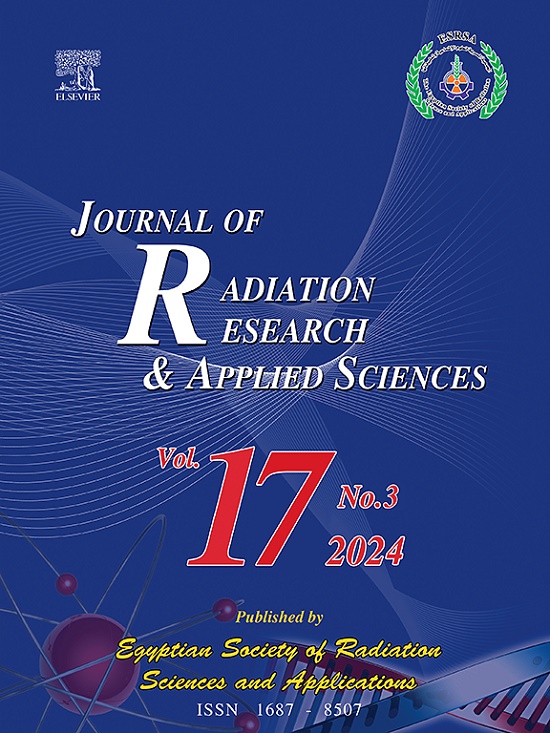DE-UNeXt: Dual encoder UNeXt for intracranial hemorrhage segmentation on a novel HBU CH dataset
IF 1.7
4区 综合性期刊
Q2 MULTIDISCIPLINARY SCIENCES
Journal of Radiation Research and Applied Sciences
Pub Date : 2025-05-10
DOI:10.1016/j.jrras.2025.101551
引用次数: 0
Abstract
Objective:
Intracranial hemorrhage(ICH) is one of the highly fatal diseases. Clinically, CT scans are key for doctors to assess the extent of hemorrhage and develop treatment plans. However, there are currently few publicly available pixel-level ICH datasets, which limits the improvement of CT image segmentation performance for intracranial hemorrhage. To address this problem, this paper proposes a new intracranial hemorrhage image dataset, HBU CH, which aims to provide rich, diverse, and realistic intracranial hemorrhage cases. Meanwhile, an end-to-end intracranial hemorrhage segmentation network, DE-UNeXt, is proposed to improve the segmentation accuracy of the lesion parts.
Methods:
First, a Dual Encoder Structure (DE) is proposed, where both the original image and its inverted counterpart are input into two parallel encoders. This approach captures object features from two complementary perspectives, enabling the learning of a richer feature representation. Next, a Dual Feature Compensation (DFC) Module is proposed, which combines traditional convolutional methods with contextual Transformers to process and fuse the features extracted from the DE structure in parallel. The DFC module accounts for both local spatial information and global semantic context, thereby enhancing segmentation accuracy and refining lesion boundaries.
Results:
Experiments conducted on the proposed HBU CH dataset, as well as two widely used datasets – BCIHM and BHSD – demonstrate that the proposed DE-UNeXt, built on a lightweight network, outperforms the baseline method. Specifically, the Intersection over Union (IoU) and F1 score of DE-UNeXt show improvements of approximately 3.06% and 2.01%, respectively. The code and dataset are available at https://github.com/davidsmithwj/DE-UNeXt for further research.

DE-UNeXt:双编码器UNeXt颅内出血分割在一个新的HBU CH数据集
目的:颅内出血是高致死率疾病之一。在临床上,CT扫描是医生评估出血程度和制定治疗计划的关键。然而,目前公开可用的像素级ICH数据集很少,这限制了颅内出血CT图像分割性能的提高。为了解决这一问题,本文提出了一种新的颅内出血图像数据集HBU CH,旨在提供丰富、多样、真实的颅内出血病例。同时,提出了端到端颅内出血分割网络DE-UNeXt,以提高病灶部位的分割精度。方法:首先,提出了一种双编码器结构(Dual Encoder Structure, DE),将原始图像和反向图像分别输入到两个并行编码器中。这种方法从两个互补的角度捕获对象特征,从而能够学习更丰富的特征表示。其次,提出了一种双特征补偿模块,该模块将传统的卷积方法与上下文变换相结合,对从DE结构中提取的特征进行并行处理和融合。DFC模块同时考虑了局部空间信息和全局语义上下文,从而提高了分割精度并细化了病灶边界。结果:在提出的HBU CH数据集以及两个广泛使用的数据集(BCIHM和BHSD)上进行的实验表明,基于轻量级网络构建的DE-UNeXt优于基线方法。其中,DE-UNeXt的IoU和F1评分分别提高了约3.06%和2.01%。代码和数据集可在https://github.com/davidsmithwj/DE-UNeXt上获得,以供进一步研究。
本文章由计算机程序翻译,如有差异,请以英文原文为准。
求助全文
约1分钟内获得全文
求助全文
来源期刊

Journal of Radiation Research and Applied Sciences
MULTIDISCIPLINARY SCIENCES-
自引率
5.90%
发文量
130
审稿时长
16 weeks
期刊介绍:
Journal of Radiation Research and Applied Sciences provides a high quality medium for the publication of substantial, original and scientific and technological papers on the development and applications of nuclear, radiation and isotopes in biology, medicine, drugs, biochemistry, microbiology, agriculture, entomology, food technology, chemistry, physics, solid states, engineering, environmental and applied sciences.
 求助内容:
求助内容: 应助结果提醒方式:
应助结果提醒方式:


